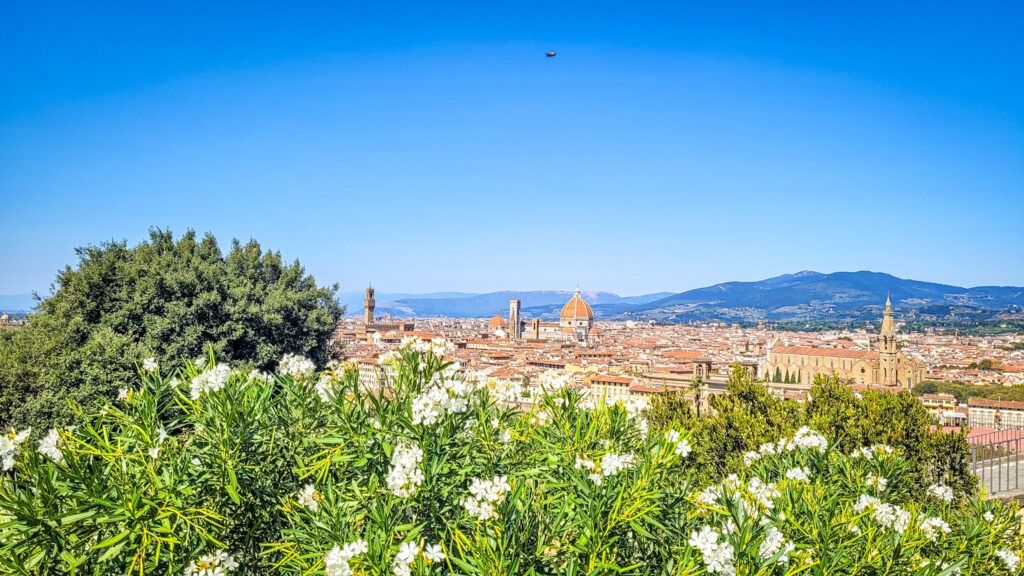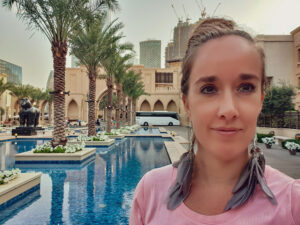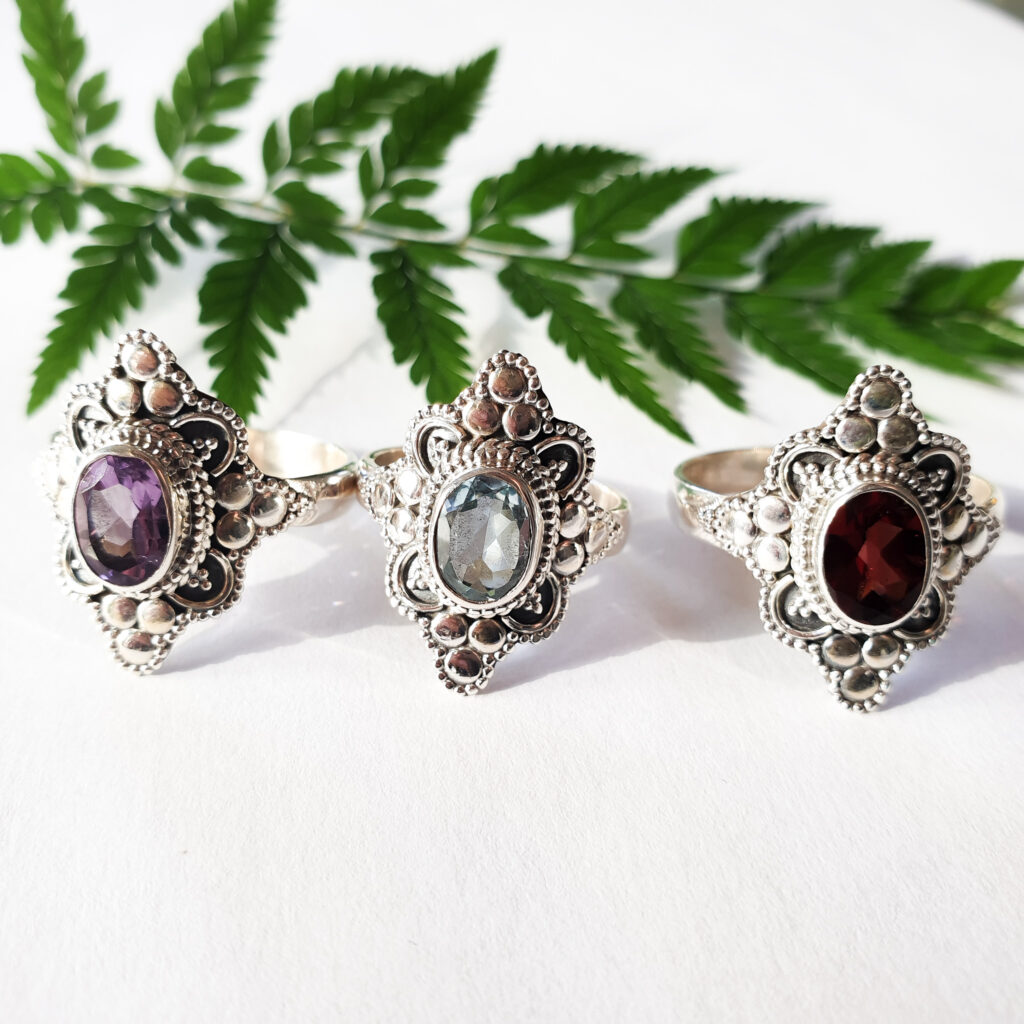Florence is the capital of Tuscany and one of the most fascinating destinations in Italy. Known for its art, architecture, and history, Florence is home to some of the most famous monuments in the world. From the stunning Duomo to the fine arts collection of the Uffizi Gallery. There is no shortage of incredible sights to explore. In this blog post, I guide you through some of the most monumental highlights to visit in Florence.

Table of Contents
Cattedrale di Santa Maria del Fiore
The Cattedrale di Santa Maria del Fiore is one of the first things that attract visitors to Florence. The cathedral was built in the 13th century and is an outstanding example of Italian Gothic architecture. It took nearly 140 years to build, and it is made entirely of exquisite marble.
One of the most iconic features of the Cattedrale di Santa Maria del Fiore is the enormous and imposing dome. Designed by the artist and architect, Filippo Brunelleschi in the 15th century, the dome remains one of the most incredible architectural wonders ever built. The dome is one of the largest in the world and is regarded as one of the most magnificent creations of the Renaissance era.
The cathedral’s facade is another outstanding feature. It is known for its detailed carvings and is made up of a total of three portals, each showcasing different artistic styles. The bronze doors of the cathedral, designed by Lorenzo Ghiberti, are also impressive and depict scenes from the Bible.
Inside the cathedral, visitors can marvel at the beautifully preserved and ornate frescoes painted by renowned artists like Paolo Uccello and Andrea del Castagno. The central nave is enormous, with the altar located directly under the dome. Visitors can also explore the Baptistery next door, which is one of the oldest structures in the Piazza del Duomo and has some of the finest mosaics and metalwork in all of Italy.
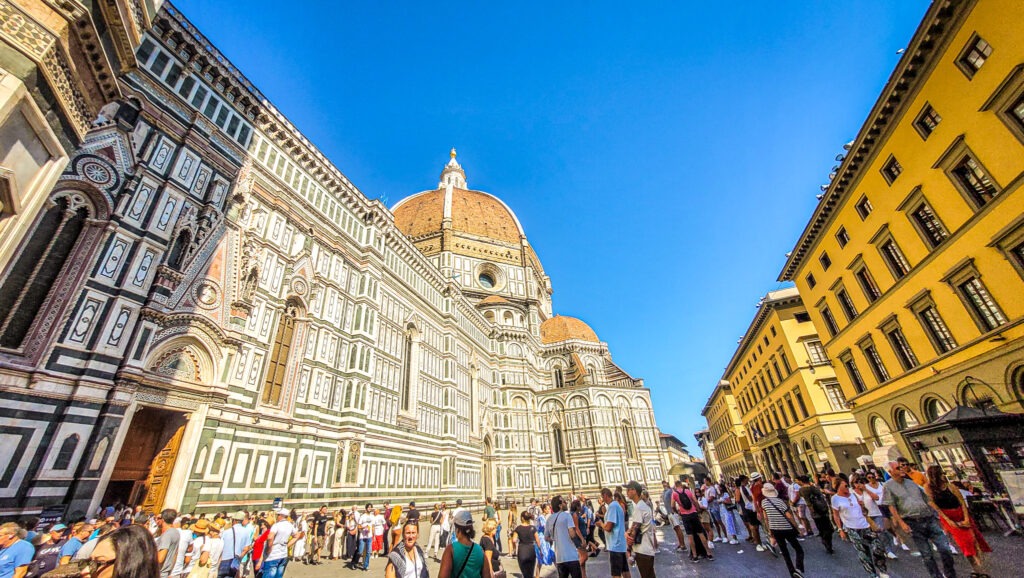
Uffizi Gallery
The Uffizi Gallery was originally built as a government office in 1560 by the architect Giorgio Vasari. The name “Uffizi” comes from the Italian word for “offices,” as the building was intended to house the offices of the Florentine magistrates. Over the years, the building was expanded and improved upon by various architects, including Bernardo Buontalenti and Alfonso Parigi. The Uffizi Gallery is a sprawling complex of interconnected galleries, with an impressive facade decorated with a series of arches and balconies.
One of the most striking features of the Uffizi Gallery is its central courtyard, known as the Cortile degli Uffizi. This grand space is surrounded by elegant columns and is home to a remarkable collection of sculptures. The courtyard was originally designed to serve as a ceremonial space for the Medici family, who were the rulers of Florence at the time. Visitors can stroll through the courtyard and take in the exquisite sculptures, including works by Michelangelo and Giambologna.
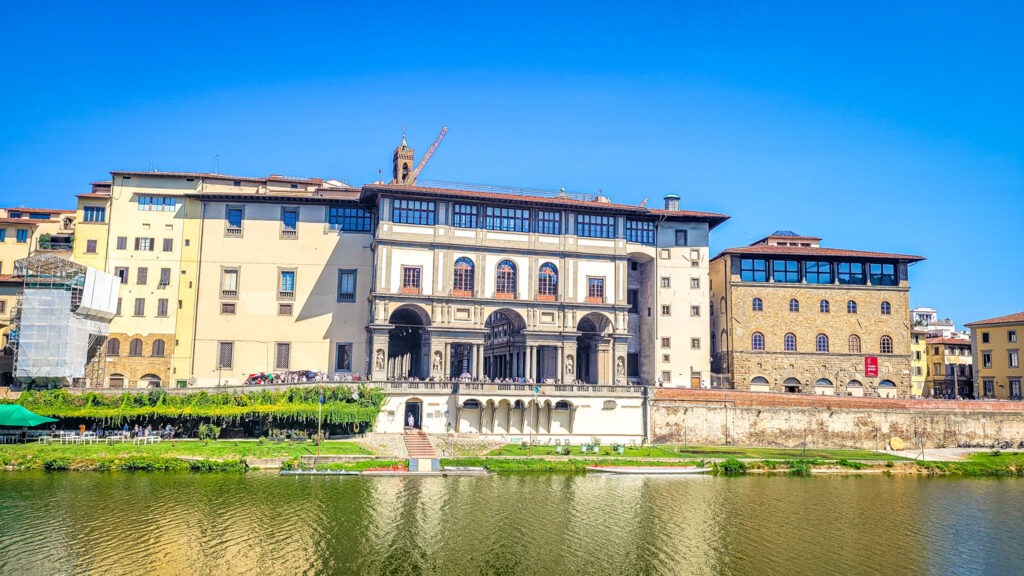
Museum collection
As visitor you go through the galleries, and you will be treated to a feast of artistic treasures. The Uffizi Gallery has an impressive collection of Renaissance art, including works by some of the greatest artists of all time, such as Botticelli, Michelangelo, and Leonardo da Vinci. Visitors will have the opportunity to admire masterpieces such as Botticelli’s famous “The Birth of Venus” and Leonardo da Vinci’s “Annunciation.” The gallery also includes works by lesser-known artists, providing a comprehensive overview of Renaissance art in Florence.
Another notable feature of the Uffizi Gallery is its stunning views of the city. From the upper floors of the gallery, visitors can enjoy panoramic vistas of Florence, including the famous Ponte Vecchio bridge and the sweeping dome of the Duomo. The galleries themselves are also exquisitely decorated, with each room offering its own unique ambiance and style.
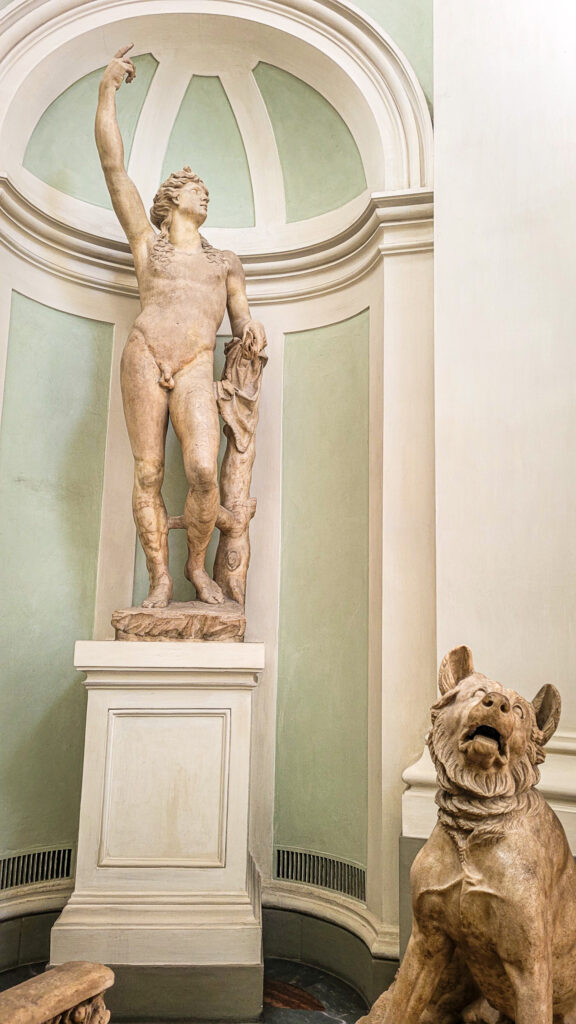
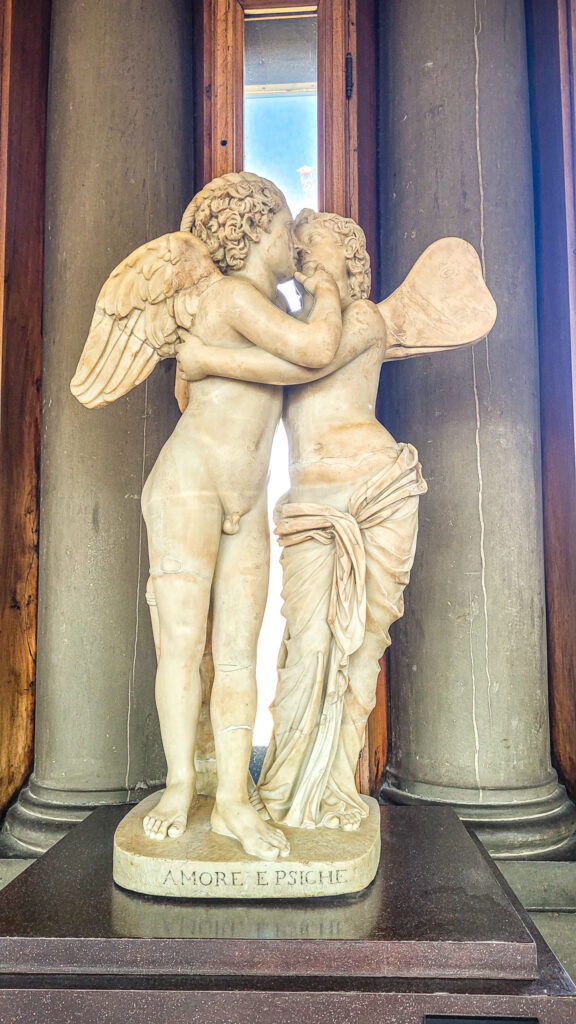
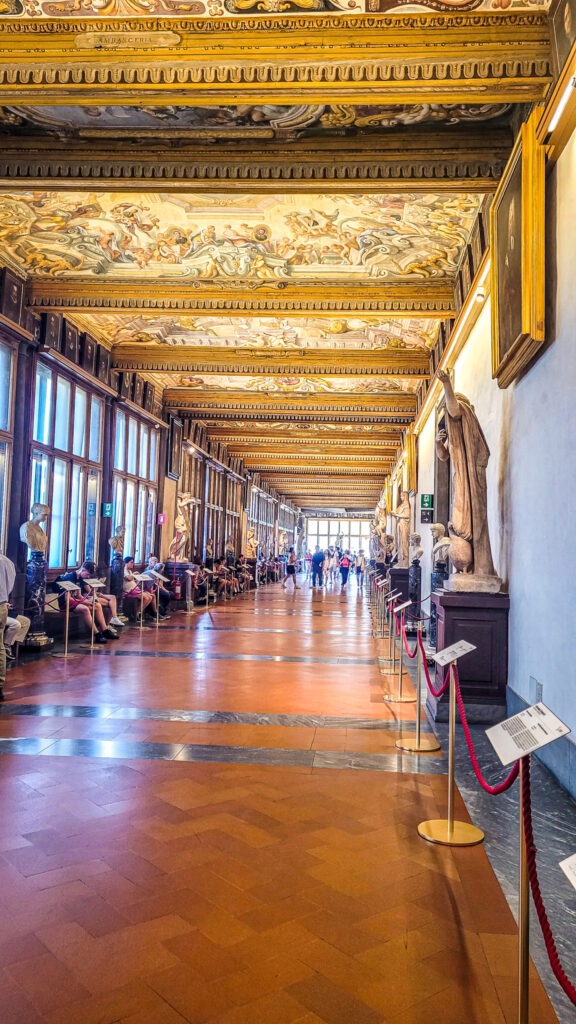
Galleria dell’ Accademia
The history of the Galleria dell’ Accademia dates back to the late 16th century when Grand Duke Ferdinand I founded the academy of Drawing, Painting, and Architecture. The academy took the title Accademia delle Arti del Disegno, one of the oldest art schools worldwide. It was in 1784 that Leopold II, Grand Duke of Tuscany, opened the gallery, making it the first public museum in Europe. The gallery was a place for artists and students to study art and learn from the works of the great masters. The collection grew over time, thanks to donations and bequests from wealthy Florentine families.
Stepping into the gallery is like travelling back in time to the Renaissance era. One of the impressive architectural features of the Galleria is its stunning vaulted ceiling, decorated with intricate frescoes depicting allegories of art and science. Breathtaking sculptures decorate the hallways, adding to the museum’s grandeur. Some of these sculptures are the masterpieces of Michelangelo, such as the four unfinished Prisoners and the iconic statue of David. The way the sculptures are arranged and displayed in the gallery is a wonderful example of Renaissance-era design and exhibits how important it was, and still is, to appreciate art.
Michelangelo’s David
The main attraction of the Galleria dell’ Accademia is, of course, Michelangelo’s David. The 17-foot-high marble statue depicts the biblical hero David before his battle with Goliath, and it’s considered one of the greatest sculptures of all time. The statue was initially placed in Piazza della Signoria before being moved to the Galleria for preservation purposes. Apart from the David, there are other works by Michelangelo, such as the unfinished sculptures known as the Prisoners and his famous Pieta.
The Galleria dell’ Accademia also houses works from other famous Renaissance artists such as Sandro Botticelli, Domenico Ghirlandaio, Pontormo, and Andrea Del Sarto. Their paintings provide insight into the techniques and styles used in the Renaissance period. The museum also offers temporary exhibitions showcasing works from other Italian artists to enrich your appreciation of Italian art.
Basilica di San Lorenzo
The Basilica di San Lorenzo’s history dates back to the fourth century, when it was first built by Saint Ambrose, the Bishop of Milan. It was Florence’s first cathedral, and it served as the city’s principal church until the eleventh century. The current structure was reconstructed in the fifteenth century, beginning with Brunelleschi’s redesign of the interior and the Old Sacristy.
The interior of the Basilica di San Lorenzo reflects its historical and artistic significance. The Old Sacristy, built by Brunelleschi, is a masterpiece of Renaissance architecture and sculpture. The sacristy features a central altar, two side chapels, and a dome with intricate patterns and decorations. The dome’s lower section is decorated with sixteen exquisite false windows, painted by Paolo Uccello and Andrea del Castagno. The sacristy’s walls also feature some of the most significant artworks from Renaissance artists, including Filippo Lippi, Verrocchio, and Michelangelo.
The Basilica di San Lorenzo’s exterior is equally impressive, with a simple, understated design that reflects the Florentine Renaissance style. The façade of the church was designed by Michelangelo, but it was never finished, leading to a mix of designs. Nevertheless, it reflects Michelangelo’s style and has become a landmark of the church.
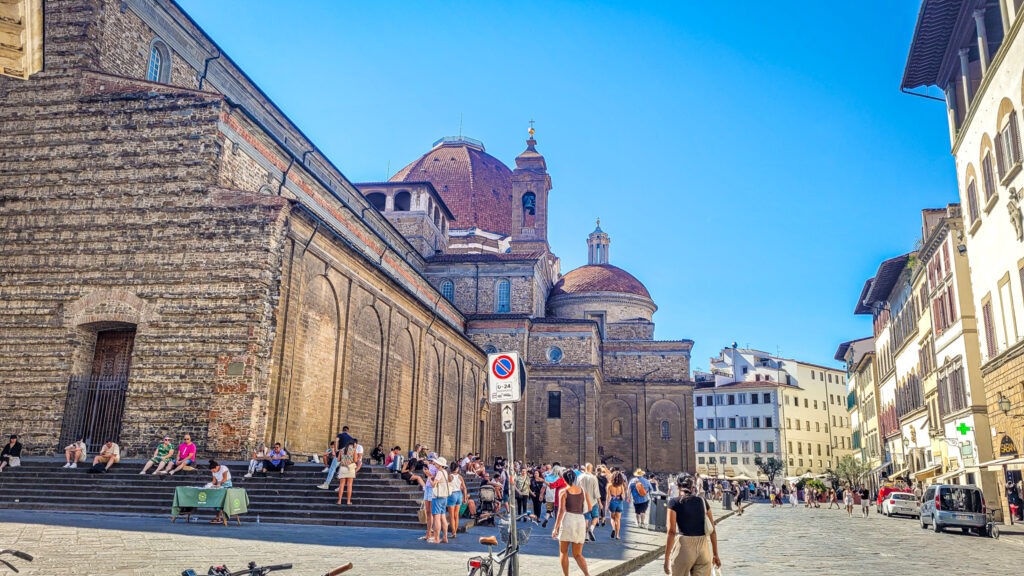
Chapel and tombs of the Medici
Walking through the church, you can’t help but marvel at the beautiful chapels that line the nave of the basilica. The most significant of these is the Medici Chapel. It was designed by Michelangelo in the 16th century and is a tribute to the powerful Medici dynasty. The chapel features an exquisite series of statues known as the Medici Tombs, which were also crafted by Michelangelo. The lifelike figures of Lorenzo the Magnificent, his brother Giuliano, and their relatives are among the most beloved sculptures in the chapel.
In addition to its artistic treasure, the Basilica di San Lorenzo is also of historical and cultural significance as it has remained the burial place of the powerful Medici family for centuries. The crypt of the Medici Chapel houses the last resting place of many of the great Medici lords, including Cosimo and Lorenzo.

Palazzo Medici
The Palazzo Medici was initially built in the 15th century by the Medici family, who were influential bankers, politicians, and patrons of the arts. The palace was meant to represent the immense wealth and power that the Medici family had attained. It was designed by Michelozzo di Bartolomeo, who blended classical and Renaissance styles to create a magnificent architectural masterpiece. In the early years, the Palazzo consisted of two blocks, one facing Via Cavour and the other overlooking Via dei Gori. The two blocks were later connected, and a courtyard was added to create a unified structure.
Renaissance interior
One of the most striking features of the Palazzo Medici is its architectural style, which combines elements of classical architecture with Renaissance ornamentation. The building’s façade, for instance, is characterized by a series of arches and columns that create a sense of symmetry and balance. The building’s windows are also finely decorated with stone frames and leaded glass panels, adding to the palace’s ornamental beauty. The double-flight staircase is another notable feature of the Palazzo Medici, which leads to the second floor. Some of the most stunning rooms in the palace include the chapel and the family library. The chapel is dominated by its richly decorated Renaissance vault and stained-glass windows.
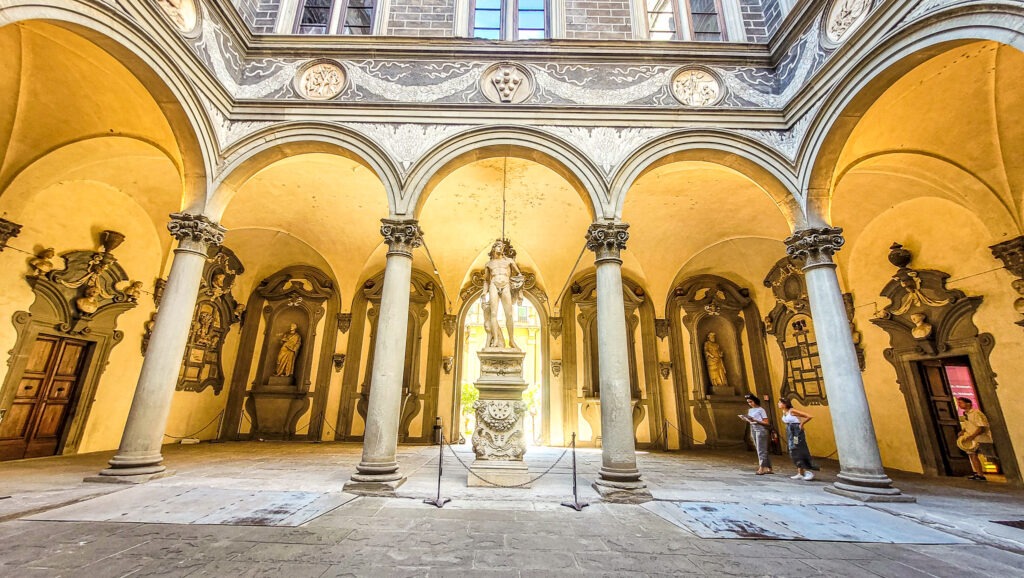
History
The Palazzo Medici also has an incredible history. During the Renaissance period, it was a hub for artistic and intellectual activities. Many famous artists and scholars, including Leonardo da Vinci, Michelangelo, and Galileo Galilei, visited the palace and worked on several projects for the Medici family. The palace has witnessed many significant events throughout history, such as the Pazzi Conspiracy that aimed at assassinating two Medici brothers, Giuliano and Lorenzo, in 1478. The conspiracy eventually failed. The Medici family was able to exert even more power and influence throughout Florence.
In addition to its impressive history and architecture, the Palazzo Medici houses several collections. One of the most famous museums is the Medici Riccardi Library, which contains a vast collection of manuscripts, books, and art pieces. The museum is open to the public, and visitors can explore the library’s unique collection and learn more about the Medici family’s legacy. There is also the Silver Museum, which displays a precious collection of silver artifacts, such as cups, dishes, and jewellery, created by Florentine artists and silversmiths. The museum’s collection is a testament to the city’s long tradition of master craftsmanship, which dates back to the Renaissance period.
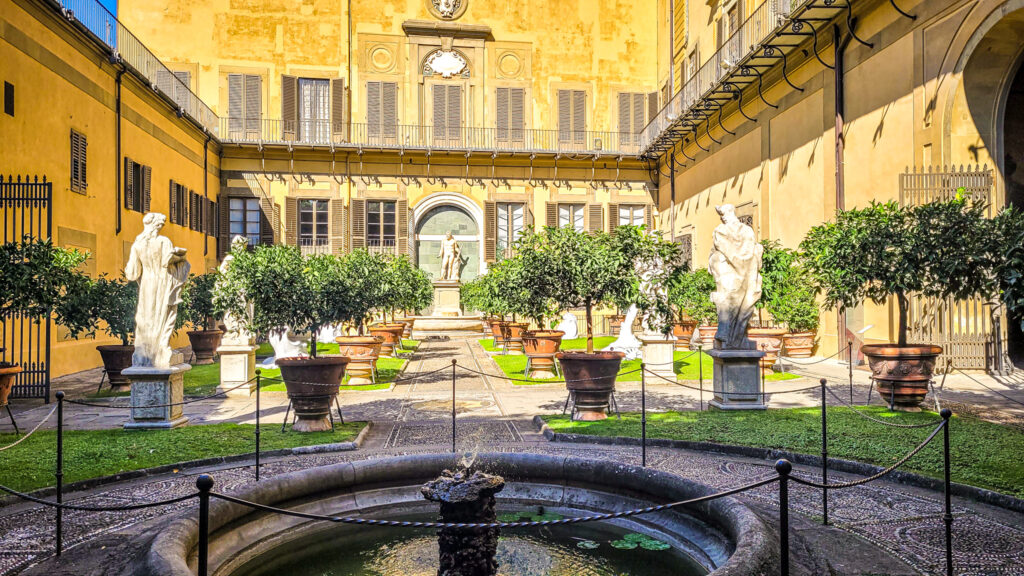
Museo Leonardo Da Vinci
Leonardo Da Vinci was born in 1452 and a genius of his time. He made significant contributions to varied disciplines such as art, engineering, science, and architecture. When he passed away, he left behind an impressive legacy: drawings, manuscripts, and inventions that fascinated the world. The Museo Leonardo Da Vinci, situated in the heart of Florence, houses a collection of his works that includes models, interactive exhibits and rare documents. The collection spans his entire life and offers a unique view of his amazing work and thought process.
The museum offers a complete sensory experience, with the exhibits organized not just chronologically but also by subject matter, making it easier for visitors to enjoy and appreciate his works. They also showcase models which are life-sized replicas of some of his celebrated works like the Rotary Saw and the Bicycle.
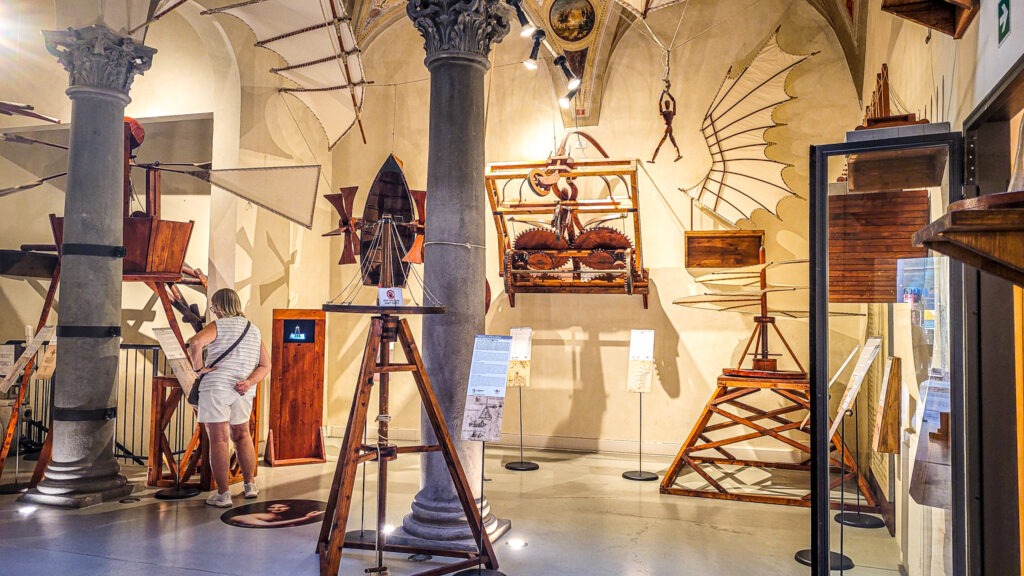
The museum has been built in a way that welcomes all visitors and provides accessibility to all its exhibits. Visitors can move effortlessly from one exhibit to another via elevators, and the ramps fitted for wheelchair users. The exhibits showcase interactive installations like the automated self-propelled car, the flying machine, and the suspension bridge.
One of the exciting aspects of the Museo Leonardo Da Vinci is that it showcases a lot of the lesser-known aspects of his life and career, making it an excellent destination for history enthusiasts. Not only are visitors able to admire Da Vinci’s incredible artwork, but they can also learn about his interest in scientific experimentation, his passion for anatomical studies, and his visionary approach to city planning. It is a chance to discover the mind of one of history’s greatest geniuses and see how he shaped the world around us.
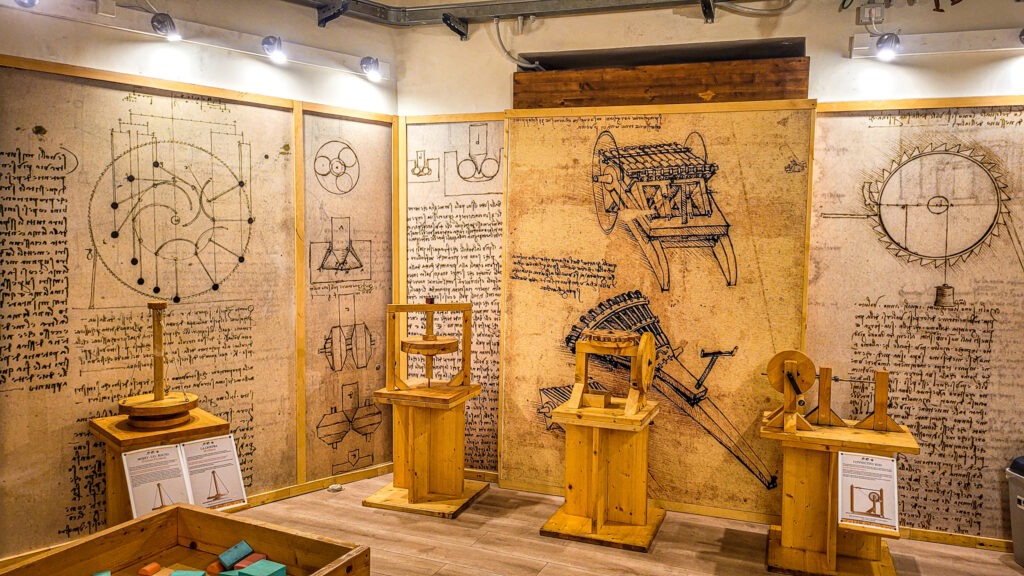
Opificio delle pietre dure
The Opificio delle pietre dure owes its existence to the long tradition of Florentine art. It was founded in 1588 by Ferdinando I de’ Medici, Duke of Tuscany. Ferdinando wanted to preserve the perpetuating art of pietre dure. Back then, pietre dure was a decorative technique that involved making intricate mosaics and inlays using precious stones and marbles. The fossils, semi-precious stones, and minerals were carefully chosen and cut with great precision. Then the stones were arranged and glued to a surface in such a way as to create a breathtaking piece of art. And the opificio was the perfect place to learn and refine these skills.
The opificio also acted as a school, where artists from all over the world would come to learn and perfect their craft. Today, it still educates students in the art of pietre dure, and you can visit the museum to see some of the finest examples of this art.
What sets the Opificio delle pietre dure apart from other museums is that it is a living, breathing workshop where visitors can see the techniques of pietre dure being created. Step inside and watch as master craftsmen carefully cut and shape the stones, creating intricately detailed pieces of art. You can also take a workshop and learn for yourself how to create a masterpiece in pietre dure.
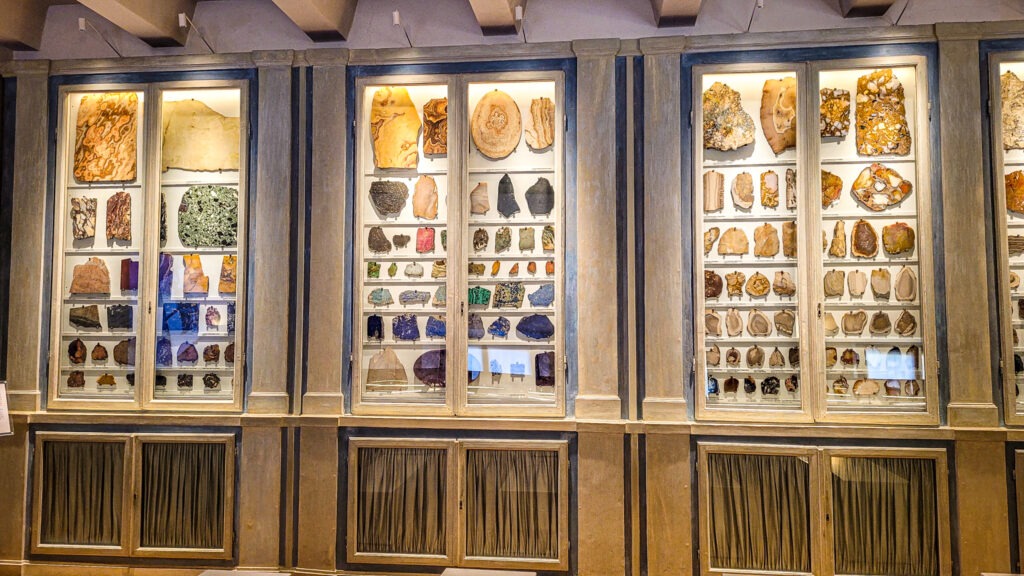
Museo Archeologico Nazionale di Firenze
The Museo Archeologico Nazionale di Firenze has a range of captivating exhibitions of artefacts and relics from ancient times. Including the Etruscan, Roman, and Egyptian civilisations. With a collection spanning over halls and galleries, visitors can explore a wealth of fascinating objects, from sculptures and pottery to jewellery and tools.
One of the most striking exhibits is the Etruscan section. The Etruscans were a significant people who lived in central Italy from the 8th to the 3rd century BCE. They were known for their exquisite craftsmanship and art, which is visible in the array of artefacts on display. One example is the world-famous Chimera of Arezzo, which is a bronze statue with a lion’s head, a goat’s body, and a serpent’s tail.
Apart from the exhibits, the architecture of the museum is also notable. The building itself is a beautiful example of the Florentine Renaissance style, designed by Giuliano da Sangallo in the 16th century. The exterior has intricate details and artistic embellishments, such as the reliefs on the facade that pay tribute to Greek mythology. The second floor houses the Egyptian collection, where visitors can marvel at the fascinating artefacts from the land of the Pharaohs.
Another highlight of the museum is the Sala degli Ori or the Hall of Gold, which is dedicated to the jewellery and metalwork of ancient Italy. Here visitors can see an array of intricate gold, silver, and bronze pieces that demonstrate the exquisite craftsmanship of the early Italians. The exhibit also showcases a number of objects from the world-famous Treasure of the Pyramids from Vulci.
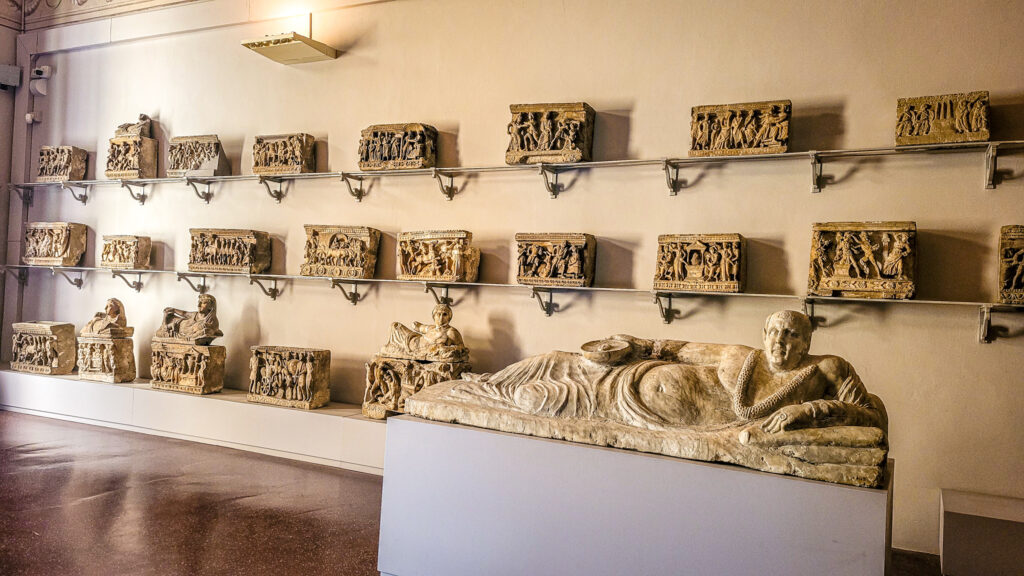
Ponte Vecchio
The Ponte Vecchio bridge spans over the Arno river and connects the two parts of the city. The unique feature of the bridge is that it is lined with shops on both sides which sell a variety of goods including jewellery, art, souvenirs and clothing. The shops on the bridge were originally owned by butchers and fishmongers. They used to throw their waste into the river, causing pollution and bad odour. In the 16th century, the Grand Duke of Tuscany, Ferdinand I ordered that the shops be given to goldsmiths instead. Ferdinand did not want the smell of dead animals polluting his palace nearby.
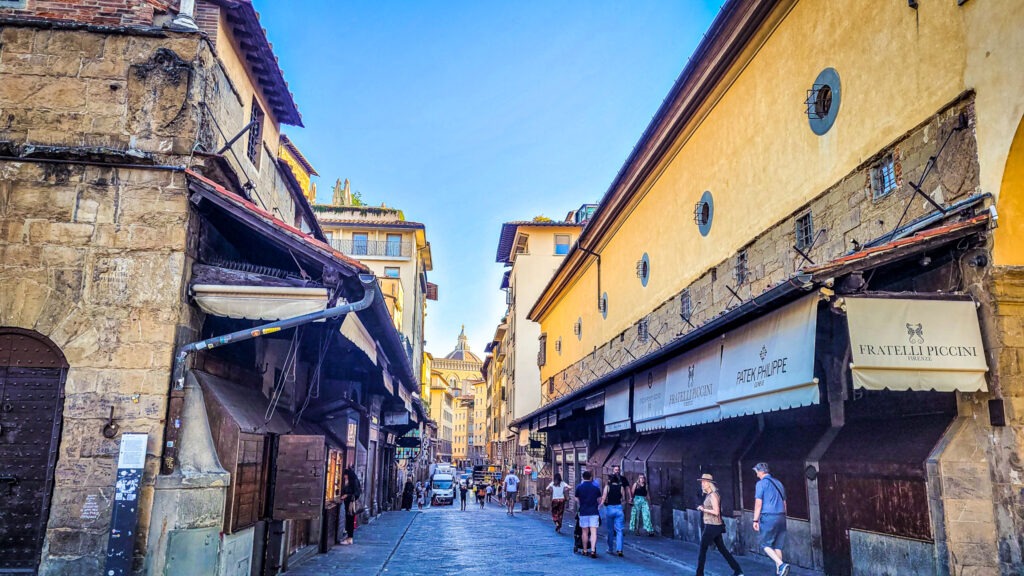
Architecture
The architecture of the bridge is notable for its arched structure and distinctive red rooftops. The bridge was built using stone and has three arches that give it a unique and charming look. The shops on the bridge are built on medieval foundations and have a wooden covering that stretches out over the river. The bridge has been restored several times over the years. The most recent renovation taking place after it was badly damaged during the Second World War.
The Ponte Vecchio has been a witness to many historical events over the years. During the Second World War, the bridge was destroyed by the retreating German soldiers, but was rebuilt soon after. In 1966, the bridge was severely damaged by the floods that swept through Florence. The bridge is also known to have survived several fires and other natural calamities.
Over the years, the bridge has also been an inspiration to many artists and authors. The bridge has been featured in several movies and books, including the famous work of Dan Brown called Inferno. It is also a popular spot for artists who come to draw and paint the beautiful views of Florence from the bridge.

Piazza della Signoria
Piazza della Signoria was the city’s seat of power for centuries. Originally built as a meeting place for the city council and public assemblies, the square was later decorated with numerous sculptures and works of art, making it an open-air museum. One of the most iconic sculptures in the square is the Neptune Fountain, which dates back to the 16th century. The fountain’s intricately carved structure and magnificent design make it an absolute must-visit attraction in the square. The imposing statue of Cosimo de Medici, a prominent figure in Florence’s history, stands tall and proud in the square’s centre, reminding visitors of the city’s rich cultural heritage.
Piazza della Signoria is also home to the Palazzo Vecchio, one of Florence’s most popular landmarks. The imposing palace was once the home of the ruling Medici family and now functions as a museum. A trip to Florence would be incomplete without visiting the Palazzo Vecchio and admiring its inspiring architecture and rich historical significance. The palace is a perfect example of Renaissance-style architecture featuring splendid frescoes, murals, and sculptures that capture the essence of Florence’s artistic past.
With so much to see and do, Piazza della Signoria is the perfect place to spend an afternoon or evening. The square is home to numerous restaurants, cafes, and bars, offering visitors a chance to indulge in some of Florence’s finest delicacies while enjoying the view of the city’s breathtaking architecture.
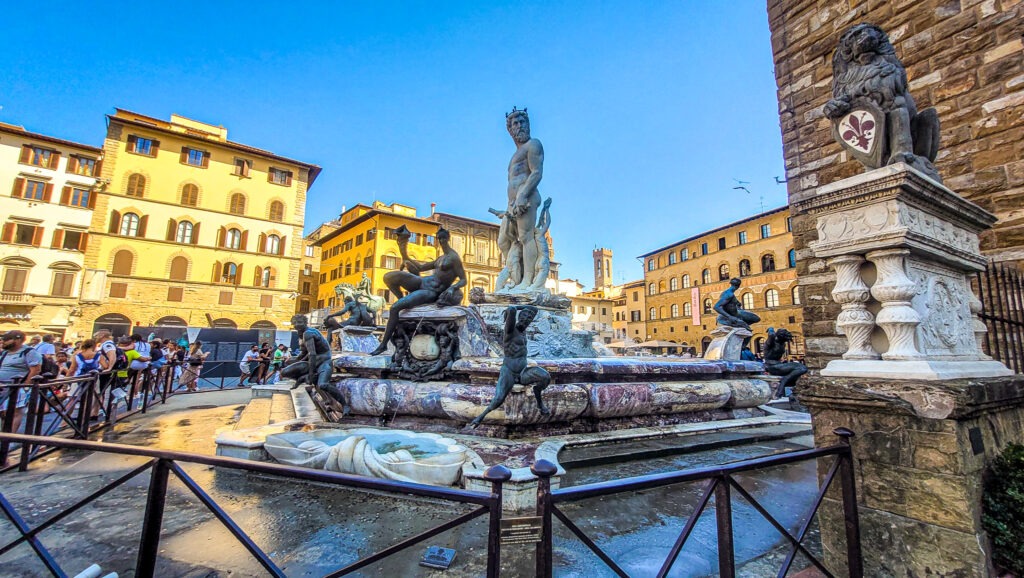
Palazzo Vecchio
Palazzo Vecchio is also known as the Old Palace and the Palace of the Signoria. It was once the residence of Florence’s ruling leaders. Today the palace serves as the city hall. The construction of Palazzo Vecchio started as early as the 13th century by Riccardo Foresconi, continued by Arnolfo di Cambio, and eventually completed by Simone Talenti in the 14th century. The building is a testament to the Gothic architecture of the medieval period, with towers, arched windows, and the pointed arches of its loggia.
The palace’s courtyard, known as the Cortile di Michelozzo, is undoubtedly one of the main attractions of Palazzo Vecchio. Commissioned by Cosimo de’ Medici, the courtyard was designed by Michelozzo di Bartolomeo in the 15th century. The impressive arches open up to an enormous space, revealing the beautiful statues of Donatello and Verrocchio. The Renaissance style of the courtyard’s arches mirrors Florence’s grandeur during the flourishing period of the Medici dynasty.
The Salone dei Cinquecento is the largest room of Palazzo Vecchio, and it is a testimony to the power of the Medici family. Cosimo I de’ Medici in 1540 commissioned the construction of the room, designed by Giorgio Vasari. Its name translates to the Hall of the 500 because it was where the City Council of Florence and the future Grand Duchy of Tuscany, consisting of 500 members, congregated. The room features beautiful frescoes such as Vasari’s “Battle of Marciano” and Leonardo da Vinci’s “Adoration of the Magi.”
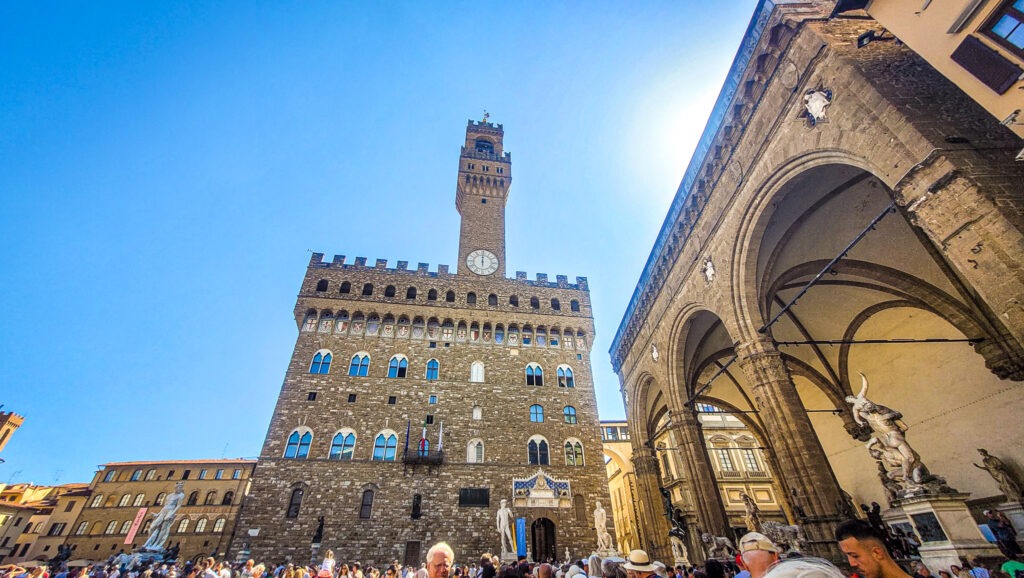
Boboli gardens
The Boboli Gardens have a fascinating history. They were commissioned by the Medici family in the 16th century, and initially served as a grand showcase of their wealth and power. They employed the best landscape architects of the time to design the gardens and used them for hosting lavish parties, tournaments, and concerts. The layout of the gardens was influenced by classical Roman and Renaissance styles. Over the years, several additions were made to the garden, including the Amphitheatre and the Viottolone. The Amphitheatre is a gorgeous outdoor oval theatre with a stone stage and seats carved into the hillside. The Viottolone is a grand central avenue that leads to the top of the hill, where you can get a panoramic view of the city.

Grotto of Buontalenti
As you stroll through the gardens, you’ll be surrounded by magnificent sculptures from the Renaissance period. The Grotto of Buontalenti is a must-see. It is an underground cave with cascading waterfalls, stalactites and stalagmites, that was once used as a cool retreat during the hot summer months. The garden is also home to several other sculptures such as the Giant from the Aurora Fountain, the Isolotto Fountain, and the Ocean Fountain, which were created by famous artists such as Giambologna and Bartolomeo Ammannati.
Architecture
The Boboli Gardens has beautiful sculptures, but it is also home to some incredible architecture. The garden has several buildings, including the Palazzina della Meridiana, a two-story palace built in the Baroque style, and the Kaffeehaus, a neoclassical building designed by the Austrian architect, Gaspare Maria Paoletti. It’s fascinating to see how these buildings blend in with the natural landscape of the gardens and become a part of the experience.
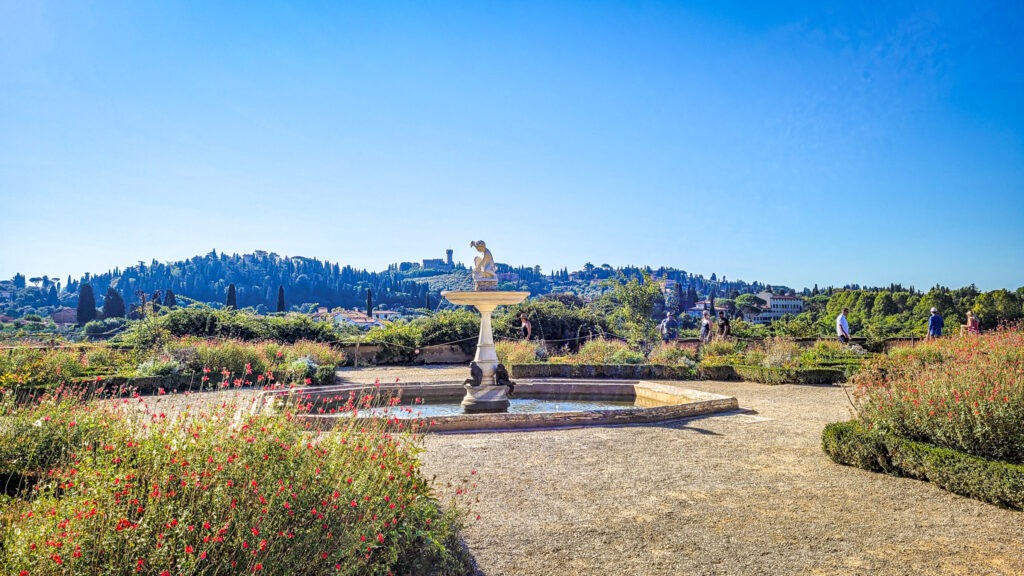
Pitti Palace
The Pitti Palace was initially built in 1458 by the Florentine banker Luca Pitti. It was later acquired by the powerful Medici family in 1539, who then made significant changes to the structure. The palace’s grandeur increased as it underwent numerous renovations to become the palace we know today. The palace features impressive Italian Renaissance architecture, with extensive detailing that includes elaborate stonework, intricate friezes, and frescoed ceilings. The palace facade consists of a central block flanked by two wings that define an Italian Renaissance courtyard. The exterior is designed in a rusticated style, featuring large stone blocks in an orderly pattern.
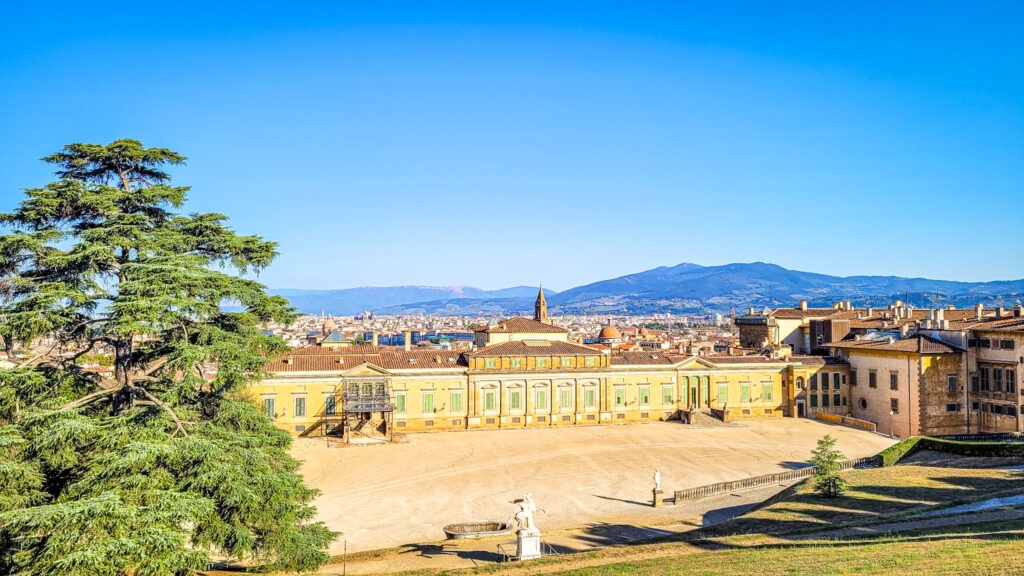
Collections
The Pitti Palace’s interior is as inspiring as the exterior, with its luxurious furnishings and impressive art collections. The Palace houses four museums: Palatina Gallery, Museum of Costume and Fashion, Silver Museum, and Modern Art Gallery. The Palatine Gallery alone has over 1,000 works of Italian Renaissance art, including paintings by Raphael, Titian, and Rubens. The Silver Museum has an incredible collection of silver objects dating back to the Renaissance era. Visitors can also visit the Boboli Gardens, which features a combination of green spaces, sculptures, and fountains that create a beautiful and serene atmosphere.
One of the most iconic features of Pitti Palace is the grand staircase designed by Bartolomeo Ammannati. This staircase is a triumph of Renaissance architecture, with its intricate details, beautiful sculptures, and stunning frescoes. The grand staircase has served as a setting for many historical events, including the grandeur of the iconic period drama, The Crown.
The Pitti Palace also housed the royal family of Italy for years, making it an essential cultural hub during that time. Visitors can marvel at the luxurious furnishings, ornaments, and artefacts that were once used by the Italian monarchs. It is a fascinating insight into the lives of one of Europe’s most illustrious royal families.
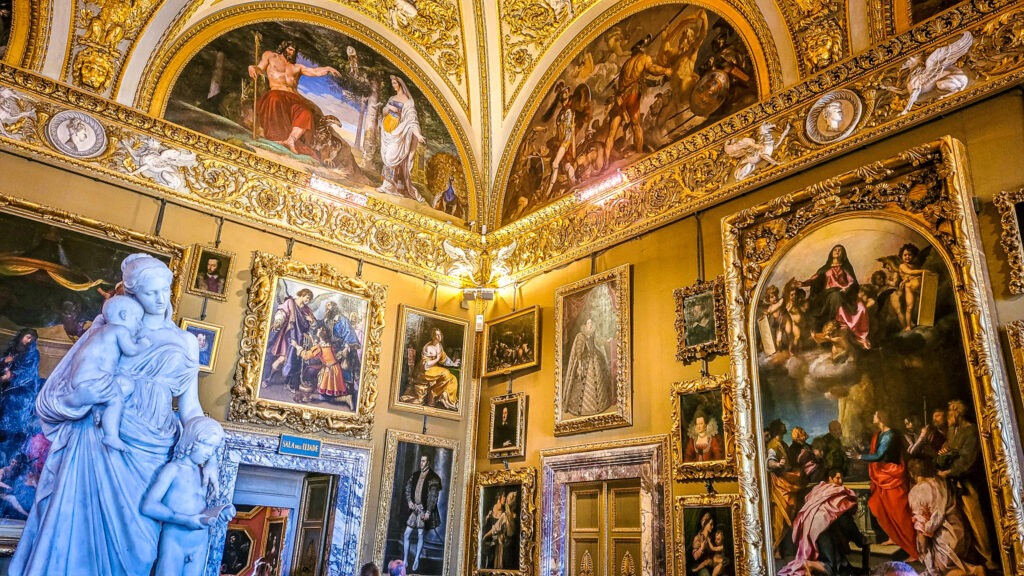
Basilica of Sante Croce
The Basilica of Santa Croce was built in the 13th century. It’s usually referred to as the “Temple of Italian Glories” because of the many cultural and historical figures that are buried there. The basilica is home to many important pieces of art and sculpture, including masterpieces by Giotto, Donatello, and Cimabue.
The church of Santa Croce is an example of Italian Gothic architecture and it has a façade with a trussed roof made of coloured marbles. The interior has an impressive layout and a cruciform plan. It´s made up of three rectangular naves, divided by two rows of pointed arches. The basilica’s most famous section is the Pazzi Chapel, a masterpiece of Renaissance architecture designed by Filippo Brunelleschi.

Tombs of famous Italians
One of the highlights of the basilica is the tombs of many famous artists, scientists, and philosophers located in the cloisters of the church. Tourists are in awe when they come across the tombs of works of art like Michelangelo, Galileo, Machiavelli, and Rossini. Their final resting places are a testament to their contribution to Italian culture and history, which still resonates today.
The basilica is unique because of its historical importance. Many important events, religious and political, have taken place here over the years. For example, the basilica has hosted religious celebrations, weddings, and even the funerals of many famous personalities. The most important event that took place inside the Basilica was the Council of Florence. The authorities tried to reunite the Eastern Orthodox and Western Catholic Churches in the 15th century.
Piazzale Michangelo
The Piazzale Michelangelo was designed by Giuseppe Poggi in 1869. He was commissioned to draw up a plan to expand the city. It was built on top of a hill overlooking Florence as part of a project to create a new area for the wealthy middle class to build their homes. The square was named after Michelangelo Buonarroti. He was one of the most distinguished artists of the Renaissance. His statue stands in the centre of the square.
One of the most impressive buildings in Piazzale Michelangelo is the Basilica of San Miniato al Monte. The basilica is situated on a hilltop overlooking the city. It was built in the 11th century in the Romanesque style. And is considered to be one of the finest examples of Tuscan Romanesque architecture. The facade is decorated with green and white marble in a geometric pattern. The interior is decorated with beautiful frescoes.

Loggia dei Lanzi & Rose Garden
Another prominent landmark in the Piazzale Michelangelo is the Loggia dei Lanzi, which was built in the 14th century as a gathering place for the public. Its name derives from the mercenary warriors who used to rent the place. The loggia features a statue of David by Michelangelo, which is a replica of the original that stands in the nearby Accademia Gallery. The loggia also houses other impressive sculptures such as Perseus with the Head of Medusa.
The Piazzale Michelangelo also hosts the Rose Garden, one of the most beautiful gardens in Florence. The garden offers panoramic views of the city and is home to over 350 varieties of roses. It’s an excellent spot to relax and enjoy the breathtaking scenery of Florence.
The most exciting part of Piazzale Michelangelo is the view itself. At the square you can get a panoramic view of Florence. The Arno River is winding its way through the city. The view is especially stunning in the evening when the city lights up. Or when the sun sets over the hills surrounding Florence.

San Miniato al Monte
San Miniato al Monte is a Romanesque church located on a hill overlooking Florence. Its construction first began in the early 11th century, although it was completed over the next few centuries, with the addition of various elements to its architecture. The church is named after Saint Minias, an Armenian prince, who was martyred in the city of Florence in the 3rd century A.D.
One of the most remarkable features of San Miniato al Monte is its façade, adorned with white and green marble that creates a striking contrast against the blue sky. The intricately carved decorations and archways demonstrate the immense artistic skill of the craftsmen of the time and offer a glimpse into the magnificence of the Romanesque style.
As you enter the church, you are greeted with inspiring mosaics and frescoes that recount the stories of the life of Christ and various saints. The mosaic decorations of the apse and main altar are particularly stunning and showcase the work of some of the greatest artists of the time.
The interior also houses unique and rare works of art, such as a wooden crucifix that is known to have miraculously moved on several occasions. The crypt houses the remains of Saint Minias, making it a site for pilgrimage for many Catholics.
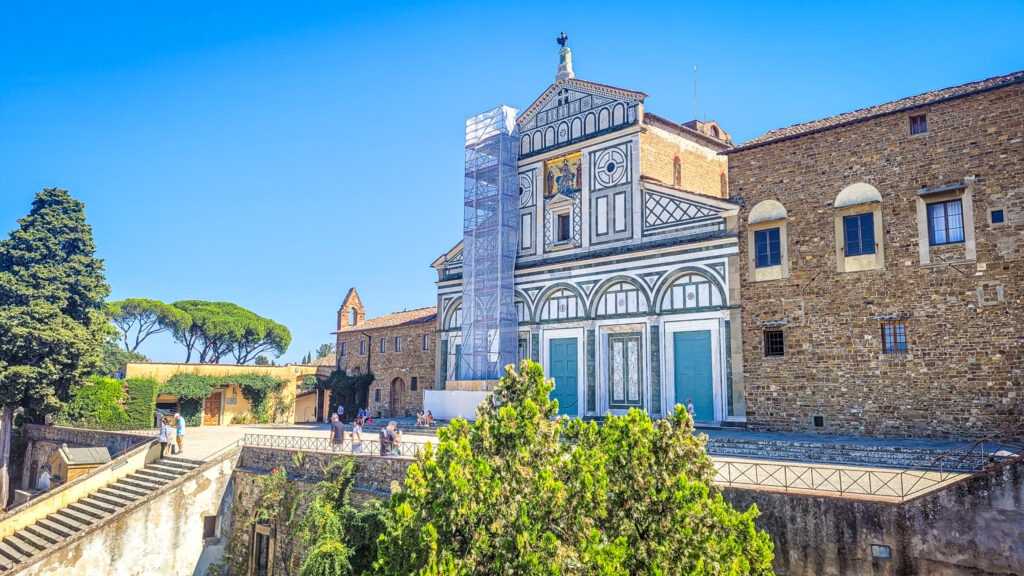
Monumental highlights in Italy
Discover the irresistible charm of Italy’s rich historical sites. Go on a journey through the monumental highlights of Bologna, one of the country’s most underrated cities. The cities history dates back to the Renaissance period, offering a cultural, artistic, and culinary experience like no other. And let’s not forget about Modena, a hidden gem where you can escape the crowds and indulge in its unique allure.
Rome presents an incredible opportunity to delve into the captivating history of the Roman Empire. Don’t miss out on this truly amazing experience when you find yourself with some spare time.
Fancy a scenic hike with an incredible view of blue pristine waters? Discover the history and architecture of Cinque Terre and unveil the hidden gems.
Experience the enchantment of Parma, Italy. It’s an exquisite destination with a rich history, culinary delights, and captivating streets. Read the article to discover the city’s architectural landmarks, artistic treasures, and other remarkable highlights.
